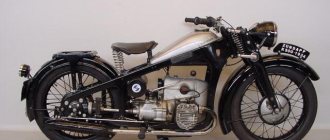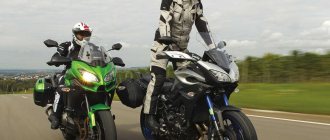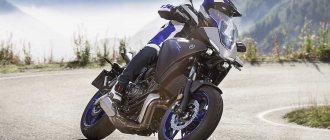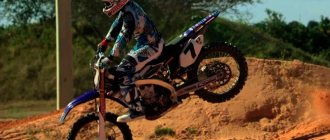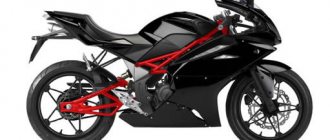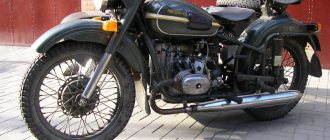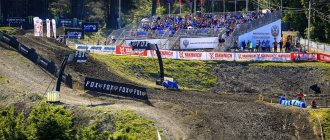Hells Angels MC
(Hell's Angels) is one of the world's largest motorcycle clubs, with chapters all over the world. Formed on March 17, 1948 in San Bernardino (California). The Hells Angels became widely known thanks to Ralph Hubert Barger Jr., also known as Sonny Barger.
The famous American writer Hunter Thomson wrote a book of the same name about the club. Under itself, Hells Angels MC has organizations such as the “Big Red Machine,” which unites individuals who support the activities of the club and the “Big House Crew.”
Now the club heads the so-called “Big Four” (the Four largest motorcycle clubs in the world), being currently the largest motorcycle club in the world.
Organization and symbolism of the club
Symbolism
The official Hells Angels club logo is a skull with wings. The logo was copied and creatively transformed from the United States Air Force unit insignia by Frank Sadlik, president of the club's San Francisco chapter. Subsequently, the image of the skull and details of the logo were changed several times.
The official colors of the club's emblem and symbols are red and white, that is, the inscriptions are made in red letters on a white background. This is where one of the club's nicknames, “The Red and White,” comes from.
Another commonly used euphemism for the club's name is 81, from the sequential number of the letters "H" and "A" in the English alphabet. This combination can be seen on the members of the so-called. “support clubs” (English support club), since only full members of the “Hells Angels” can bear the full name Hells Angels.
The club’s symbols, worn on leather or denim vests, include: “colors”, stripes on the back, consisting of three parts (two arched stripes - the upper and lower rocker, and the central part, which is just an image of a skull with wings); rectangular stripes on the chest (four pieces on which the name of the club, the location of the branch, the nickname of the biker and his position in the hierarchy of the club are written). Badges with the inscription “1%” and various abbreviations are also used.
Structure
Hells Angels MC World consists of individual chapters, that is, branches (branches) of the club in a certain territory. A chapter can be created on the basis of a motorcycle club already operating in a given region or created “from scratch” by at least six bikers who share the ideology, support the goals and objectives of the club and agree with the charter.
Before receiving the official name Hells Angels MC, for some time the club had the status of a “prospect club”, that is, it was on a “probationary period”. After some time (from one to three years), the club officially becomes part of the Hells Angels MC World structure and has the right to wear the “colors” of the Angels.
In a given chapter there is a strict hierarchy: from the so-called “hang around” to the chapter president.
Way to success
According to legend, the motorcycle club owes its appearance and its name to the 303rd Heavy Bomber Squadron of the US Air Force, which took an active part in the battles of World War II. It was she who bore the name “Hell's Angels”. And the squadron received it because of the movie “Hell’s Angels,” beloved by all pilots. After the end of the war, the pilots were left idle. The squadron was disbanded and all pilots were sent into retirement. The military, of course, felt that the country had betrayed them. Therefore, they decided to go against the system. Yesterday's warriors united against the system and began to rebel.
With the appearance of the name, it’s clear. But as for the organization of the biker club, there are two versions. The first is that former 303 Squadron pilot Arvid "Oley" Olsen brought together the Boozefighters and Pissed Off Bastards motorcycle clubs under his leadership. And when they merged, they received the name “Hells Angels.” This happened in California in 1953. The second version says that thirteen bikers traveling around the Californian city of San Barnardino in 1955 became “angels”.
One way or another, in the mid-50s the club had an official logo - a skull with wings, as well as corporate colors - red and white.
The club's surge in popularity began in the 1960s and is associated with Oakland branch president Sonny Barger. First of all, he registered the Hell's Angels brand, as well as the symbols of the club. Then he began to actively promote it. Barger initiated the first motorcycle races and introduced a system of membership fees. Thanks to the popularity of the club, the leader and some other bikers appeared in Hollywood films. And when the Vietnam War began, Sonny even sent a letter to US President Lyndon B. Johnson.
Currently, the Hells Angels are one of the four largest motorcycle clubs in the world. Their branches are open in several dozen countries, located in America, Europe, and Asia.
Relations with authorities
USA, EU
In 2014, there was an attempt to ban the motorcycle club, but the court recognized it as a legal association.[27]
In 2013, the Ontario Superior Court of Justice issued a dissenting opinion that the Hells Angels are not a criminal organization. In Australia, a similar decision was made in 2015.
In Russia
On June 7, 2015, the Federation Council published a “patriotic stop list” - a list of NGOs that should be recognized as “undesirable organizations” and included the Soros Foundation, MacArthur Foundation, Freedom House, National Endowment for Democracy, etc. Parliamentarians called on citizens to send their proposals, and Senator Viktor Ozerov mentioned the receipt of two requests from the Night Wolves biker club, with a request to include the Hells Angels MC and Bandidos MC biker clubs there. The appeal, signed by the leader of the Night Wolves and member of the Anti-Maidan movement Alexander Zaldostanov, together with the Union of Paratroopers and the Combat Brotherhood, states that these “foreign organizations headquartered in the USA” do not comply with the laws of the Russian Federation and participated in the events on the Maidan and can be used as the main fighting force during the “color revolution” in Russia[28]. On August 13, the chairman of the Federation Council Committee on Constitutional Legislation, Andrei Klishas, approached Prosecutor General Yuri Chaika with a proposal to add the Hells Angels and Bandidos to the list of undesirable organizations.
A representative of the motorcycle club, Ivan (Hippo), described such letters as “ungentlemanly behavior” and denied a number of allegations. According to him, patriots of their country participate in his motorcycle club.
In turn, the Union of Paratroopers of Siberia appealed to the leadership of the Union of Paratroopers of Russia, in which they indicated that the information contained in the letter to the Federation Council was unreliable.
Biker Wars
Naturally, other motorcycle clubs treat the Angels differently. Some consider them allies, others would not mind joining their structure, and others perceive them as enemies. Most often, conflicts flared up over control over any territory. Sometimes disputes could be resolved peacefully, but there were also full-fledged confrontations with the use of weapons. Such conflicts are usually called “biker wars.” For example, from 1994 to 1997, the confrontation engulfed the Scandinavian countries. And it went down in history as the “Great Nordic Biker War.” Representatives of a motorcycle club with the self-explanatory name “Bandidos” spoke out against the Hells Angels. That conflict claimed the lives of eleven people. Bloody confrontations also took place in Germany, England and other countries.
The wars were fought not only over control of territories where bikers were engaged in legal (selling and repairing motorcycles) but also illegal activities. Motorcycle clubs were known to sell weapons and drugs, as well as engage in racketeering and control prostitution.
In 2003, agents in the United States arrested more than fifty Angels. And sixteen of them received varying prison sentences for murder and racketeering. By the way, one of these special operations by CIA agents formed the basis of the film “Chasing the Shadow.”
In 2013, they tried to ban Hell’s Angels in America, a year later in Europe, and then in Australia. But the courts sided with the bikers, ruling that the motorcycle club was not a criminal organization.
In art
In literature
At the peak of its scandalous popularity, “Angels” were described in many works. In their own opinion[29], the best book about the club is Hunter Thompson's Hell's Angels, published in 1966.
Mentioned in the novel “The Black House” by S. King and P. Straub. The authors compare the book's heroes, the Thunderbolt Five bikers, with the Hell's Angels.
To the cinema
During the 60-70s of the 20th century, the very concept of “biker” was often associated with the “Hell’s Angels”. In particular, this is reflected in the titles of many films of this period associated with the subgenre of “biker cinema.” Several feature films featuring “Hell's Angels” have been released: “Hells Angels on Wheels”, “Angels From Hell”, “Hell's Angels'69”, “The Wild Angels”.
MY MOTORCYCLE
60 years ago, the Hells Angels club was founded in the United States, thanks to which the biker movement acquired its current form. This club created an industry around itself that brought in a stable income, despite the fact that the club members themselves always demonstrated a contemptuous attitude towards money and looked more like highway bandits than successful businessmen.
Raised from hell
The legend was born on March 17, 1948 in Fontana, California. It was there and then that a group of amateur motorcyclists announced the creation of the Hells Angels club. Later, largely thanks to the “angels,” a most effective business scheme was born that is still working. There are three important elements in this scheme: motorcycle manufacturers, an army of motorcycle fans and a small but noisy group of motorcycle scumbags who give the entire biker movement a romantic aura and thereby help the manufacturers promote their products. At the same time, the motorcycle hooligans themselves also make money from the image of reckless and brutal heroes, since the biker movement was a promising business from the very beginning.
And it all started quite decently. At the beginning of the twentieth century, a motorcycle was a rather expensive toy for gentlemen who decided to connect their lives with sports. These gentlemen, as usual, organized clubs where they had fun, including organizing competitions and going on themed picnics together. Since 1924, these clubs have been united by the American Motorcycle Association (AMA), which already in those early years had international recognition and the status of the official representative of the International Motorcycle Federation, an organization headquartered in Paris. The AMA held its own competitions and colorful motorcycle festivals, which in those days were not even remotely reminiscent of riotous bike shows with strippers and dozens of gallons of beer drunk. No less respectable motorcycle manufacturing companies like Harley-Davidson were happy to cooperate with the respectable AMA, and everyone was happy.
Meanwhile, the strange phrase “Hells Angels” has taken hold in American popular culture. In 1927, a movie was released, actually a blockbuster, directed by the future crazy billionaire Howard Hughes. Aviator Hughes made a picture about the brave pilots of the First World War, and the squadron in which they served was called “Hells Angels,” and the film itself was also called that. It became a cult favorite among American pilots, and the apt name, invented by Howard Hughes, soon took on a life of its own.
In 1937, when Japan attacked China, a group of American volunteer pilots went to beat the Japanese. With the help of journalists, the volunteer corps of American pilots in China began to be called the “Flying Tigers,” and they themselves were happy to give loud names to their squadrons. For example, Hell's Angels. One of the units of this squadron was commanded by Arvid Olsen, known for his love of engines and motorcycles. It was thanks to him that the most famous club in the history of the biker movement received this aviation name.
With America's entry into World War II, the number of Hells Angels in the American Air Force began to increase rapidly. This, for example, was the name of the famous four-engine bomber B-17 (“flying fortress”), whose crew, during a propaganda tour of the United States, encouraged the population to buy war bonds; the same name was given to several squadrons. By the end of the war, in the minds of Americans, the name “Hells Angels” was firmly associated with the exploits of combat pilots. When the war ended and the brave pilots began to return home, it turned out that good money could be made from their desire for risk and adventure.
During the war years, Harley-Davidson became a monopolist in its field. The company supplied thousands of motorcycles to the American army and became a very large enterprise. When the war ended, the army began to sell off its motorcycle fleet at a low price, and many Americans happily purchased two-wheeled vehicles. Retirees bought them with particular pleasure, since Harleys were familiar to them from their military service. Many of them, wanting to put into practice the technical skills acquired in the troops, opened workshops in which they tinkered with Harleys. These mechanics were creative. Former soldiers and young Americans who wanted to be like them craved the thrills that their peaceful lives were so poor in. Motorcycles, in principle, provided these sensations, but military Harleys were too heavy and clumsy. Mechanics struggled with these defects of Harley-Davidson products. They removed everything unnecessary from the cars, leaving only the engine and frame. Turning lights, fenders, metal shields that covered the rider's knees - all this had to be eliminated. The craftsmen tried to lower the saddle lower and raise the handlebars higher so that the motorcyclist could sit upright, putting minimal strain on his hands. This is how choppers appeared, motorcycles with a distinctive appearance, which served as a sign of a special relationship with motor vehicles. The construction of choppers became the first specifically biker business, which is still thriving today. The first, but far from the last.
The cheapness of Harleys turned motorcycling into a mass hobby for young Americans. In the 1940s, the number of motorcycle clubs grew rapidly, and ordinary workers and employees became their members. Most of the new motorcyclists were young people, and when they got together, they were not averse to getting a little rowdy and drinking a bottle or two of beer. Having had fun on the weekend, these guys returned to their daily duties on Monday and again became disciplined workers. However, print publications decided to capitalize on the nascent biker movement, and soon some motorsports fans abandoned their generally decent lifestyle.
On July 4, 1947, a motorcycle rally organized by the AMA took place in the Californian city of Hollister. The leadership of the association could not even imagine what a stir this event would cause among motorcycle enthusiasts. Overnight, the sleepy little town was overwhelmed by a crowd of about 4 thousand people, many arriving on their own motorcycles. Since Hollister's bars and hotels could not accommodate all the many guests, they drank alcohol on the streets and immediately went to bed. Some clubs organized motorcycle races directly in the city, scaring away the inhabitants with the roar of engines. There were fights, of course, too, and there was plenty of trash.
But all these events looked even more terrible on the pages of yellow and yellowish newspapers. The press reported that an army of dissolute motorcyclists “captured the city” and almost let it be plundered. Life magazine, for example, published a photograph of a drunken subject who had fallen asleep on a motorcycle parked in the middle of a bar, surrounded by empty bottles. The photo was staged, but it had a considerable effect. Motorcyclists immediately became the number one topic in the country. Frightened by the scandal, the motorcycle association issued a clumsy statement in which it assured that motorcyclists for the most part are respectable citizens, and only 1% are rowdy. “We condemn them,” said the president of the AMA. “They would not be condemned if they rode horses, mules, or rode bicycles. But, unfortunately, they turned to motorcycles.”
However, not all motorcyclists felt a sense of remorse. Many, out of spite for the AMA, declared themselves “one percenters” and loudly declared that rowdy behavior and alcohol were an integral part of their new lifestyle. Soon clubs began to open that did not want to have anything to do with the AMA and immediately classified themselves as “one percenters.” One of these was the Hell’s Angels club, whose members soon showed everyone how a biker differs from a simple motorcycle enthusiast.
The new club was founded by respected biker Otto Friedli, who led his supporters away from the Pissed-off Bastards club. Fridley and his friends had had a lot of fun in Hollister and were now eager to continue the fun. By some miracle, the ex-“bastards” managed to attract combat pilot Arvid Olsen, one of the above-mentioned “Flying Tigers,” into their ranks. However, the officer quickly figured out what was what and decided that he was not on his way with the hooligans. Nevertheless, the name of the new club was given precisely with his light hand. Perhaps others would have followed Olsen, and the nascent movement would have left the scene, but there were too many who wanted to capitalize on the brutal image of bikers. Following the press, Hollywood took up the matter. In 1953, Laszlo Benedek's film The Savage, based on the events in Hollister, was released. The role of the leader of a gang of bikers in leather jackets was played by Marlon Brando. Brando’s cruel and unpredictable “savage” turned out to be quite charming, the film quickly became a cult among rebellious intellectuals and youth, and the image of a man on a Harley became a symbol of freedom and protest. So, thanks to the press and cinema, a new hero was born - a tramp motorcyclist who has problems with the law, but also has self-esteem and a love of freedom. The hero turned out to be very American. The ideal biker seemed like a revolutionary, a cowboy, a gangster and a combat pilot at the same time, so ordinary Americans could not help but secretly admire this new pop culture character. Films about bikers began to be released regularly, the demand for leather jackets grew, and motorcycles went in great demand.
The history of the biker movement would probably have turned out differently if not for one man who possessed the qualities of a charismatic leader and a shrewd businessman. Ralph Sonny Barger was and still is the most famous and respected leader of the Hells Angels; It was he who turned the club into a legend and at the same time into a profitable commercial enterprise.
Ralph Barger was born in the Californian outback in 1939 into a family that could hardly be called prosperous. His mother ran away with a bus driver when Ralph was four months old, and his father was a complete alcoholic. At school, young Barger appeared infrequently and mainly to fight. At the age of 16, he was completely expelled from the school for hitting a teacher with a baseball bat. Then the young man, having forged his birth certificate (adding a couple of years to himself), entered the army, where he became acquainted with motorcycles and weapons, which became his favorite subjects throughout his life. The birth certificate fraud was soon discovered, and Barger was kicked out of the military. But Sonny did not lose heart and eventually created his own army. In civilian life, Barger joined the ranks of the Hells Angels and in 1957 founded a chapter of the club in Oakland, California.
The Oakland “branch” differed from all other “angelic” branches in the strictest discipline and unconditional devotion of its members to the leader, Sonny Barger. The Auckland “angels” regularly paid their membership fees and did not dare miss a single club meeting or race - a collective motorcycle rally. But the main difference was the seriousness with which the bikers took their status as “one percenters.” Barger's people had no other interests than the club, and none of them knew or wanted to know another life. Auckland bikers were mostly guys from the poor outskirts, doing odd jobs and somehow miraculously saving up money for a chopper. However, Sonny Barger was excellent at finding money, although his methods of earning money were mostly illegal. Under his leadership, the bikers got involved in petty racketeering and drug trafficking.
But Barger had no intention of turning into an ordinary bandit. He officially registered the Hells Angels as a business enterprise, and since then Hells Angels Inc. owns the copyright to the club name, as well as the so-called colors, including the winged skull emblem. Corporate status allowed the club to acquire property. These were mainly clubhouses, garages and repair shops, but nothing prevented people from storing something illegal there, such as drugs.
The unquestioned authority of Sonny Barger was testified by journalist Hunter Thompson, who rode a motorcycle with the “angels” for a whole year to write a book about them. “When ‘angels’ gather,” Thompson wrote, “whether there are only five of them or one hundred and fifty, the chief among them is unmistakably identified: Ralph Sonny Barger, the Undisputed Leader, six feet tall, 170 pounds, warehouse owner from East Oakland - the brightest and coolest head in the whole bunch, a cool, quick-thinking dealer, with just some kind of business in mind. He is now a fanatic, now a philosopher, now a brawler, now a cunning and subtle compromiser, now, finally, a judge of last resort. To the Oakland Angels, he's Ralph. Everyone else calls him Sonny... Barger's word is law, despite the fact that many in the party could kill him in no time if push came to shove. But this has never happened... Any other characters from the table of ranks try to keep a low profile at regular Friday parties, otherwise their image will simply disappear from the screen of existence and forever change their behavior and way of thinking, so much so that their paths will never cross with the Hells Angels again.
Under Barger's leadership, the Angels became a unique organization. On the one hand, it was a typical gang that terrified everyone around them, living according to its own concepts and in constant squabbles. One day, for example, a group of nine bikers from the Diablos club beat up one of the “angels.” A month later, Diablos disbanded, unable to withstand the “angelic” terror. The “angels” caught the “devils” and mutilated them one by one until they fled in all directions. On the other hand, it was a public organization that knew how to fight for its rights. Thus, Barger organized an exemplary protest campaign against the law that prohibited riding a motorcycle without a helmet. For any biker, the thought of a helmet on his head is unbearable. Moreover, the “angels” even abandoned leather jackets, which provided at least some protection in case of a fall, and replaced them with cotton vests or simply sleeveless shirts. A 1966 federal law specifically targeted “reckless riders.” The US Congress has threatened to cut highway maintenance funds by 10% for any state that does not force its bikers to wear helmets. The bikers accepted the challenge, and soon a whole biker camp with roaring motorcycles settled near the building where California legislators were meeting. The nerves of the deputies could not stand it, and the “angels” were given the opportunity to ride as they liked.
The main achievement of Sonny Barger was the creation of a unified style in clothing and behavior of all “angels” and, to a certain extent, all bikers in general, since other clubs quickly began to copy the “angelic” habits. The undisputed Leader ensured that his colleagues fully identified themselves with the club and its “colors”. Hunter Thompson wrote: “The Angels play their part seven days a week: they wear their colors at home, on the street and sometimes even at work, and they ride their bikes to the neighborhood grocery store for a quart of milk. An “angel” without his “flowers” feels naked and vulnerable, like a knight without armor. A Sacramento cop once asked the 5.5-foot, 135-pound angel, “Why are you hanging on to all this?” “Nobody bothers me while I’m running around in my flowers,” he answered. “If I’m without flowers, I feel out of place.”
Federal officials also noted the uniformity in the habits of the “angels.” “Perhaps the main indication of being an angel,” said one official report, “is their habitual vile behavior. Police officers conducting inquiries continually report that these people, whether they were members of the club themselves or their girlfriends, could do with a good bath. "Fingerprints are very helpful in identifying individuals, as many Hells Angels have extensive criminal records."
Having become carriers of their own unique style, the rustic and not very educated “angels” found themselves at the crest of the American counterculture. The famous Ken Kesey, author of the novel One Flew Over the Cuckoo's Nest, willingly communicated with them. Kesey was the leader of a group of hippies called the Pranksters who experimented with LSD. Psychedelia captivated the “angels,” but not enough to forget about motorcycles and indulge in meditation. As for Hunter Thompson, who wrote a book about “angels,” his biography was no less vivid than that of Sonny Barger himself. Thompson was tried for robbery, served in the army and traveled around Latin America penniless. But his main merit was the invention of a new genre of journalism, when the reporter is at the center of the events described and turns from an outside observer into a newsmaker. It must be said that after a year of traveling together, the “angels” realized that Thompson wanted to make money from a book about their club, and they subjected the journalist to “trampling,” that is, they beat him half to death and threw him out of the gang. But readers appreciated his book with a long title - “Hells Angels: The Strange and Creepy Saga of Illegal Motorcycle Gangs.” Thompson became a major cultural figure as a result. What can we say about the numerous stars and starlets of rock and roll, who rejoiced at any opportunity to appear in the same company with bikers or to be like them in some way.
It seemed logical that if the authorities simply closed the “angels” club, declaring it a criminal organization, there would be more than enough reasons. But already in the mid-1960s it became clear that the destruction of the “angels” would deal a heavy blow to the national industry. The fact is that they considered themselves true patriots and therefore did not touch motorcycles made abroad. Harley-Davidson remained the main motorcycle manufacturer in the United States, but it was actively being squeezed out by Japanese and European competitors due to the low quality and high price of Harleys. Sonny Barger himself admitted in an interview: “The Hells Angels started riding Harleys mainly because they didn’t have much choice... It was always important for the Angels to ride American cars. If we talk about quality, I personally don’t like Harleys. I ride them because I'm in the club, and that's part of the image, but if I could choose, I'd ride a Honda or a BMW... As I always say: "Fucking Harley-Davidson!"
In Harley-Davidson's reserve, only old connections with law enforcement agencies remained - the army and police continued to purchase from it - as well as bikers, for whom choppers made on the basis of Harleys were part of their image. Since it was the “angels” who set fashion in the biker world, Harley lobbyists simply could not allow anyone to encroach on the bearers of winged skulls.
The criminal inclinations of the “angels” were constantly realized in the form of dangerous crimes. Here's how Newsweek magazine described the biker rally in 1965: “A growling pack of 200 black-jacketed motorcyclists converged on the sleepy little southern California town of Porterville. They went on a rampage in local bars, shouting obscenities...At one bar, half a dozen motorcyclists brutally beat a 65-year-old man and tried to kidnap a waitress.” “Angels,” like other “one percenters,” were often brought to trial for robbery, rape, hooliganism, resistance to authorities, drug and weapons trafficking, etc. However, the biker elite, in the best traditions of the mafia, always remained untainted. It was the custom of the “angels” that a newcomer who sought the honor of joining the club would undergo a probationary period, during which he had to carry out all orders of the club authorities. It was these subjects who performed the dirtiest and most dangerous work, so it was very difficult to catch and imprison a venerable member of the club. The “Angels” even got away with murder, committed in front of many witnesses and filmed on several cameras. On December 6, 1969, the organizers of the Altamont concert, the finale of the Rolling Stones' US tour, invited "angels" as security. At the concert, which took place in the open air, several other well-known groups were supposed to perform in addition to the Rolling Stones, and about 300 thousand spectators gathered. The “Angels”, who undertook to maintain order in exchange for beer, were soon thoroughly drunk and increasingly rudely stopped the audience’s attempts to reach to the stage. The situation began to get out of control. During a quarrel with one of the “angels,” an 18-year-old African American named Meredith Hunter, who had taken acid before, as usual, pulled out a gun. He didn’t have time to shoot because biker Alan Passaro stabbed him with a knife and killed him. The court recognized the actions of the “angel” as self-defense, although Hunter was stabbed five times.
Meanwhile, an industry of related products has grown around the growing biker movement. Bikers, including the most law-abiding ones, needed to maintain their style. They needed bandanas, leather jackets, earrings, tattoos, boots and other accessories; someone had to make and sell all of this. Often, former or current bikers took over this business and opened specialized enterprises. Some brands have achieved cult status among bikers. As for large business, in addition to Harley-Davidson products, Levi's jeans and Miller beer are in a privileged position.
The market for biker services expanded as wealthy and very wealthy people joined the movement. At first, the rich bikers had a complex because they were confused with Fr. Hunter Thompson, for example, wrote about the torment of members of the Madison Avenue motorcycle club, whose members included family doctors, film producers, psychoanalysts and other cream of New York society: “Ted Develet, a film producer, complained bitterly that the leather jackets he wore and other members of the club, harm their image as decent citizens." But over time, having a chopper and running around on it, dressed in a leather jacket, bandana and Levi's jeans, became a special millionaire chic. The trendsetters, as always, were actors and musicians. Suffice it to recall the movie star Mickey Rourke, who throughout his life strived to live up to the image of a tough guy and acquired several Harleys. Prosperous businessmen and top managers began to acquire choppers, and many bought their first bike when they were well over forty. Choppers and bandanas helped people fight a midlife crisis or simply allowed them to fulfill a youthful dream. Firms began to emerge that were specifically focused on serving wealthy eccentrics who decided to play tough guys on cool bikes. For example, in 1973, entrepreneur Walter Kuntze opened the first company in Germany in Kassel to produce motorcycles that looked exactly like choppers from American films. Motorcycles from AME Chopper Products were safer and had less vibration, so they met the demands of the decent public, as well as the strict requirements of the German traffic police.
Thus, thanks to the obscenities of the Hells Angels and the clubs that followed their example, a profitable, legitimate and respected industry has arisen, meeting the needs of very discerning and wealthy clients. Other areas of counterculture also became commercialized over time, and the scenario was the same. In front of everyone, there were stars who acted as hooligans, showed off, swore bad words and died from heroin. The stars were imitated by masses of fans who tried to dress the same way, play guitars the same way and behave the same way, and the business provided them with such an opportunity. It happened with the rockers of the 1970s, it happened with the punks of the 1980s, the same thing is happening now around hip-hop artists, who often have a criminal past and a criminal present.
While legal business was unfolding around the biker movement, the Hells Angels themselves did not forget about the illegal business. For example, in 1994, the so-called Quebec biker war broke out in Quebec, Canada. It all started with the fact that the local branch of the “angels” decided to take control of the entire drug trade in Montreal. They were opposed by another biker group called “Rock Machine”. Pistols and explosives were used, so the fighting was carried out in the best gangster traditions. The war continued with varying success until 2002, with total casualties amounting to about 150 people, including innocent bystanders and police officers. The war ended with the victory of the “angels,” who managed to exterminate most of their enemies, but soon the winners found themselves in the dock, and then behind bars.
But in the USA, authoritative “angels” don’t even think about getting caught. The legendary Sonny Barger still leads his gang, which includes many grizzled veterans who spent their entire lives in the saddle of a motorcycle. Sonny himself is not getting any younger either. He was diagnosed with throat cancer, and in 1983 Barger's vocal cords were removed, so now the old biker speaks only with the help of a special device implanted in his throat.
Club branches today exist in 29 countries, including Russia, each branch successfully sells goods with club symbols. The business model, first tested by bikers, continues to live and work successfully. For example, thousands of fans are ready to imitate the rapper Fifty Cent, about whom it is known for certain that he was a former drug dealer and barely survived after several gunshot wounds. Thus, open opposition to society, its laws and morals is still very attractive in purely human terms and therefore very profitable from a commercial point of view.
Hells Angels and the police
Such races brought not only joy and entertainment, but also problems. After all, due to constant complaints, the police paid attention to them. They were arrested for drunk driving, fighting, smashing stores, and so on.
The Hells Angels gang often got into scandals with the police / photo Getty Images
The Motorcycle Association always came to the defense. They convinced law enforcement officers that 99% of motorcyclists are law-abiding American citizens who were just a little carried away. But the 1% are already those who are outside the law. This is how the “1%” tattoo appeared, which symbolizes, to put it mildly, not very law-abiding bikers.
Hells Angels Charters
After Sonny Barger founded the first club in the 50s, a clear structure took root on the West Coast of the United States. Six Hells Angels charters then opened, maintaining autonomy but operating as a single organization.
What is a charter? This is the regional chapter of the Hells Angels. As of 2022, 466 charters are registered in the world - these are 5 continents and 58 countries.
Who is included in Hells Angels charters:
• “President” – the leader of the charter, who is the face of the club; • “Officers” – deputy leaders; • “Soldiers” are ordinary members of the club, each of whom has their own responsibilities: someone is involved in social networks, someone organizes parties, and so on. • Prospects are persons on probation. • Hanging around – new people who want to join in.
There are 466 Hells Angels charters in the world / photo Getty Images
When Hells Angels participate in races, their column is formed exclusively in this hierarchical order.
How to join the Hells Angels
Unlike other gangs, joining the Hells Angels club is very difficult. Candidates for membership are called Hanging around. Next, you need to earn trust and move on to the Prospect title.
To become a full-fledged participant, you need to prove that you are worthy to be called that and wear their symbols. To do this it is necessary: – to carry out any orders both day and night; – help and support the charter you want to join; – meet the selection criteria. For example, women and black people are not accepted into the club.
For dangerous ways to make money Hells Angels - see the program.

